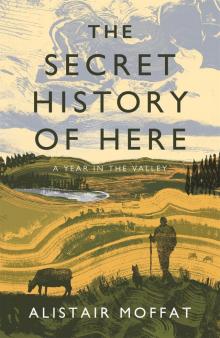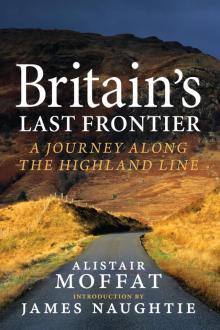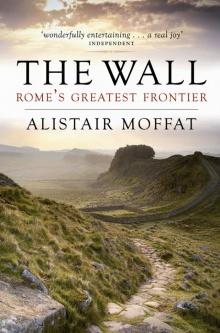- Home
- Alistair Moffat
The Secret History of Here Page 29
The Secret History of Here Read online
Page 29
16 October
To keep the mice manageable and chase off the absurdly confident rabbits, Tabitha has at last been released from her confinement in one of the looseboxes. Now that she has been spayed and is immune from the attentions of visiting tomcats, she has taken to roaming far and wide across her new territory. The only difficulty is that it is not only her territory. The sight of her languid, feline elegance has sent Maidie into paroxysms of rage.
But the terrier’s diminutive stature has supplied a partial solution to the endless barking. Adam had the idea of attaching a film that acts like frosted glass to the bottom part of the floor-to-ceiling windows that form part of two walls of the farmhouse. That successfully restricts Maidie’s view outside and has been a mercy. However, a clash will come someday, but I hope by that time Tabitha is bigger, faster and a better climber.
Keeping a tight hold of the lead, scanning the foot of the hedges for a half-hidden kitten, I took Maidie up to the Top Track. Below us the shreds and tatters of a shifting mist edged over the Tile Field and the woods beyond. The dawn sun made the russet trees below Howden Hill glister like wet gold, and the hollies and geans were hung with silver, dew-drenched gossamer. On mornings like this the landscape of precious metals shifts, seems unfamiliar, boundaries fade and the tracks disappear into the imagination. Splashes of sun light the wild cherries for a moment, and then they fade. It was as though Maidie and I walked through a forming world, emerging, morphing from centuries of poetry, of mysticism, echoes of music rising and dying away, of the distant clangour of war and the battles of half-forgotten kings.
What dunted me out of this shapeless reverie was a loud protest. My neighbour has herded some of his cows into the winter byres and they were trumpeting, their baying complaints echoing around the valley. From this summer’s lush grass, he has harvested a vast store of silage, as well as some good hay, and what the cows lack in freedom will be made up by the sickly sweet flow of fodder into their mangers.
17 October
Like moths we are drawn to the light. Perhaps that is why mornings seem like the best time, a new beginning every day, a promise. This morning the light was again shifting constantly from gold dust in the west to grey overhead as the warming world woke. For a moment, the rising sun backlit the trees of Greenhill Heights, and then they vanished.
18 October
The burnt orange of the fallen birch leaves has been seeping into the puddles on the Top Track and, even on a grey day, they are luminous. In the drizzle, Wendy, her foal and their companion, the little mini-Shetland Blossom, were contentedly sheltering under the stand of willows in the centre of the home paddock. Some years ago one of the runs of fired clay drains from the Tile Works fractured and the middle of the paddock became platchy, an apt Scots word for waterlogged. Instead of the expense of repairs, we planted five willows in a small copse and fenced it. Over the years, they have drawn up most of the water and dried the ground. Now about thirty-five-feet tall, the trees supply enough of a canopy for shelter. They have grown into a giant mushroom shape because the horses often browse the lower branches. Willow contains salicylic acid, a natural painkiller and an ingredient in aspirin. The older horses know this and bite off regular doses. And, into a rich bargain, the willows are elegant and lush, the silvery undersides of their leaves contrasting with the grey-green of the upsides when a breeze blows. It is rare that any plants supply four enduring benefits.
In the morning dark, I heard a vixen shriek in the Bottom Wood behind the stables. It is too early for the mating season and so perhaps she was asserting territorial rights. But who was threatening them? When I went to check on the mares and the Old Boys, a big old dog fox loped across Huppanova no more than twenty yards from me. Not even casting a look in my direction, his tail was straight out, his head low and his self-carriage purposeful. Looking as though he was on a mission, the old fox was taking a calculated risk in the open. But why? If his libido was stirring on this damp morning, I suspected it would not impress the vixen.
19 October
So many birch leaves had fallen in the night wind that the puddles of the Top Track were like pools of blood. From the streaky colour of blood oranges, they had become the shocking, vivid scarlet of gore. Rather than a season of mellow fruitfulness, I saw the slaughter of autumn. At about eight in the morning, it came on to rain heavily and the blood was washed out.
20 October
A blearing north wind blew this morning and the leaves were falling fast and continuously. The grass by the side of the Bottom Track is a speckled yellow carpet and in a short time all will decompose and disappear into the rich earth as winter comes on.
22 October
By 1851, Anne Moscript had moved out of our farmhouse and much higher status had replaced her. The second census was more detailed, and probably more accurate. The head of each household was identified, almost always a husband, and the occupations of each occupant were clearly listed. It was a busy landscape and around the shores of the old loch, what became the Tile Field, no fewer than forty-nine people lived and worked, three generations of adults, children and grandchildren. Now there are seventeen and only my wife and I do anything like farm work. At Hartwoodburn farmhouse lived the matriarch, Agness (the spelling is still a little erratic) Dun, a seventy-year-old lady who had not appeared on the 1841 census. And at the Henhouse lived the youngest, a five-month-old baby, Barbara Spiden.
The youngest child of William and Janet Spiden, she was looked after by Agness (sic) Dinwoodie, a seventeen-year-old servant. William’s occupation is listed as ‘Overseer of landed estate’, a slightly clunky reference to management of the Haining estate. Two other children, Martha and James, ran about the house, going in and out of the same door as my granddaughter, Grace, probably making the house come alive just as she does. These three little ones may have slept in one of the upstairs bedrooms, with their parents in the other, and Agness in a box bed in the kitchen.
Knowing a little of the lives of these cheerful ghosts animates our house; the gossamer traces of their lives are like warm ashes in the morning grate. When I riddle them and light the woodburner, smoke is drawn up the same chimney and out into the morning air, floating over the familiar fields. It is especially good to know their names and what they worked at. Work makes a place come alive.
Down by the Common Burn, at the foot of what is now our garden, one of the first things I came across was an old septic tank. It had been built from the orange bricks of the Haining Tile Works. Such was William Spiden’s status as the overseer of the estate, I wondered if he had had a sewage drain dug and the tank installed. If he did, it leaked. In the small paddock between the house and the burn, now used as a dog run, the moles have dug up jet black mounds of earth, made rich by generations of sewage. Most of the outflow from six users will have gone straight into the burn. Shit history.
Old maps show a spring in the wood next to the Bottom Track and it probably supplied clean water. So many generations of tree roots have disturbed that ground, it is hard to see where a collecting tank might have been, but I have come across a scatter of more orange bricks just across our boundary. The spring still bubbles up near the Wood Barn, but we have managed to direct its hesitant flow into a drain.
Across at the Tile Works, nine people lived in Alexander Wilkinson’s cottage. One of his two sons had married and given him and his wife a granddaughter, named after Mary Wilkinson. Her brother lived with them. An exotic exception, the census lists John Donaldson as a Chelsea Pensioner who had served in the Royal Artillery. The birthplace data alongside the Wilkinsons shows that this family of artisans, skilled tile and brick makers, had moved long distances to practice their specialised trade. The younger children were born near Cullen in Banffshire on the coast of the Moray Firth. Alexander and his three sons are described variously as Tilemaker, Brick and Tile Burner, and Farm Tile Work(er).
It seems that they learned their craft at Tochieneal Tileworks, where thirty to forty men were employed i
n a very profitable business for the farmer. His acumen in converting poor, low-yield fields of clay into large profits was much lauded and imitated at the time. It may have been the model for the Haining Tile Works. At Tochieneal, archaeologists have found many examples of fired-clay products and the D-shaped flat-bottomed field drains and the oversized bricks are exactly the same as ones I have found around the farm. When they moved two hundred miles south, the Wilkinsons clearly brought manufacturing techniques and solid knowledge of what products to turn out.
Up at Haining Rigg (sic), where a new house is now being built (very slowly), lived William Miller, a hedger. He was seventy, still working in 1851, and the only person out of a population of forty-nine who also appeared in the previous census in 1841. All of the others at Hartwoodburn and at the Henhouse are new or recent arrivals. This scale of turnover was common in nineteenth-century farms and a consequence of the feeing system. At hiring fairs in local towns, farm workers were taken on for six-month or year-long terms by farmers.
These were not slave markets, but they looked like them and could be demeaning. My own ancestors were almost all ploughmen and bondagers, and sometimes at the end of each term they came back to the hiring fair in Kelso Square, where they stood with hundreds of other farm workers and their families. If they were leaving a farm, they waited to be ‘spoken to’ by a different farmer looking for employees and agreed the terms of their fee, the cash payment, the tied cottage and their gains. Those who were not spoken to were left standing, publicly humiliated.
In the early 1980s, I recorded interviews with older people who could remember the hiring fairs. They ceased after the Second World War. Helen Pettigrew’s family were grocers and bakers:
The hirings were busy days with all the bakers and grocers. Days before the day itself we had to get up early to start baking to have enough for everybody who wanted pies, cakes or bread.
I remember the farm workers standing in groups in the Square waiting to be hired. It was awful, very shaming for them. The first year we were up at the shop in Bridge Street, it was a very wet day and the farm workers were waiting at the door. They came to Kelso in open carts and they hadn’t the oilskins then. They stood in the street knocking at the shop door to get in.
Rodger Fish’s family ran a garage in Kelso and his family had relatives who came into town to be hired. His mother fed them pies and broth:
The whole thing was rather awful, it was like a cattle market, except with people. My mother used to sit at the top window in Bridge Street to watch all the carts coming past with the furniture piled up on them. This was when they were actually having to move, when they had not been ‘spoken to’ by their previous employer and they [hoped they] were going to another farm. They had long carts and the horses were all decorated with beautiful harness, and pom-poms and little bells on their breast collars. Invariably the fellow driving the horse and the husband would be sitting on the side of the cart. At the back there was always the horsehair settee with the wife sitting on it and all her children sitting alongside her.
23 October
As I brought in logs to light the woodburner, I thought of the Spidens, their busy little house with a baby and two young children. Where there is silence now in the early morning, there would have been bustle as Agness Dinwoodie unhooked the black kettle from the swee and poured boiling water over the oats to make porridge.
24 October
Through the morning darkness I saw Grace dancing. Framed by a lit window in her house (only a few yards from the farmhouse), my three-year-old granddaughter was giving it everything: arms flailing, feet stomping, hips swaying, head flicking from side to side. Her whole attention seemed fixed on the television in the corner of the room. Perhaps she was watching a music video. When I stepped outside with Maidie and set off the outside light sensors, Grace turned to see me and waved, her face radiant – before she carried on dancing. At 7 a.m. it was wonderful to see such uninhibited joy and those images will keep a smile on my face all day.
25 October
The first hard frost of the oncoming winter left a crust of white icing on the grass. Apparently more extremes wait, with the possibility of a very cold winter beginning early.
I have cut enough logs, the snowplough that fits onto the front of the quad bike sits right next to it and we have ten bags of winter grit. I shall check the Calor gas cylinders that run the kitchen hob and make sure the spare is replaced if it is empty.
Even though values slipped to minus four, the Old Boys, the mares and the minis seemed happy enough. It may be frosted, but there is still plenty of grass and horses will always eat that in preference to anything else.
26 October
At dusk, the sky was darkened even more when a huge flock of crows gathered over the grass parks on either side of the Long Track. Continually moving, wheeling, soaring and diving, often in spirals, they are impossible to count, but I estimated more than a thousand. Very animated, some of them even frantic, their caw-caw calls raucous, they seemed to be massing for the night roost. Now that the trees of the Top Wood are gone, save for the two old sycamores, and the wood at the foot of the Haining Loch has been felled, they perch in long, broken black rows on the electricity lines, like Morse code.
The behaviour of these descendants of the dinosaurs is strange and unsettling. I have seen crows certainly fighting, buzzing each other, even with beaks outstretched. My impression is that there are family groups (some birds are significantly smaller, almost certainly juveniles) and in a huge flock there must be rivalries over food, mates, perhaps even territory. The unrelenting, harsh soundtrack encourages the sense of conflict. Even though we often see crows pecking at roadkill (so confident that when a car approaches they hop unhurried to the verge, and then hop back once it has passed), the big flocks seem to forage in the fields, probably after worms and other invertebrates. I read that they are omnivorous. Owls are feared, and the dense flocks that mass for winter roosts probably feel safer in such numbers.
27 October
There are some concepts that bend my brain, that I simply cannot grasp. Compared with the basics of string theory or quantum physics, the clock change is a tangled knot for me. I cannot work out how the clocks going back last night is going to have any effect on my sleep, or my day. I generally get up when I wake up and even though it was nominally 5 a.m., not 6 a.m. like it had been yesterday, I still got dressed, shuffled along to the bathroom to clean my teeth and began the day. The animals don’t wear watches and they needed to be fed, no matter what the law says the time is.
This biannual madness was triggered by a man called William Willett. In 1907, he wrote a pamphlet, The Waste of Daylight, which bemoaned the light mornings of summer. One June morning Willett was out riding his horse in Petts Wood, a suburb in southeast London, when he noticed how many houses had their blinds down. As a wealthy and successful builder whose business prospered in summer and all but shut down in the bad weather of winter, he proposed that the clocks be moved back by eighty minutes in increments of twenty over four weeks. His men could start work earlier, build faster and Willett would become even more prosperous.
No one paid much attention until the outbreak of the First World War. In 1916 both Britain and Germany adopted Willett’s suggestions by turning the clocks back by an hour in spring in order to increase the production of armaments and output in other industries vital to the war effort. In the Second World War, double summertime, turning the clocks back by two hours, was adopted for the same reason.
Much later, a European Union directive insisted that all member states adopt the practice of advancing the clocks by one hour on the last Sunday in March (depending on the date of Easter, for some reason I could not discover) and turning them back an hour on the last Sunday in October. Because of its northerly latitudes, Iceland was exempted. In 2017 any member state that wished to was allowed to opt out because studies showed that the clock change had no discernible economic impact and that, in fact, it could threaten w
ell-being. A significant number of people were found to suffer from a version of jet-lag each time the clocks were changed.
All of which just shows how utterly daft this practice is. When William Willett was out on his horse, he had presumably got out of his bed early, when it was light. When he saw all the blinds down in Petts Wood, why did he not propose the simplest solution? What he had just done himself. Get up earlier. If the sun is up at 4.30 a.m., get up. And if you do, go to bed at 9 p.m. Simple.
All of which just shows how daft chronology can be. What matters is the turn of the seasons, the light, the length of the day, the weather – and not a chronometer.
28 October
A brilliant sun rose in a cloudless, still sky and the smoke from our chimney plumed into the crystal air. Across the Tile Field, in the houses around the farm steading, more fires were lit, for it was a hard frost morning. As I walked up the Bottom Track, I thought of smoke spiralling from flames that had been kindled for ten thousand autumns in this place. By the time I reached the holly tree at the corner, I had acquired a shadow and the tissue-thin leaves of the birches had become translucent, glowing with sunlight.
Along the Top Track, Lindsay dug through the thick grass on the verge this afternoon to plant daffodil bulbs. It feels like a long haul until springtime, but we live, work and plant in hope.
29 October

 The Secret History of Here
The Secret History of Here The Night Before Morning
The Night Before Morning To the Island of Tides
To the Island of Tides Arthur and the Lost Kingdoms
Arthur and the Lost Kingdoms Britain’s Last Frontier
Britain’s Last Frontier The Faded Map: The Lost Kingdoms of Scotland
The Faded Map: The Lost Kingdoms of Scotland The Wall
The Wall